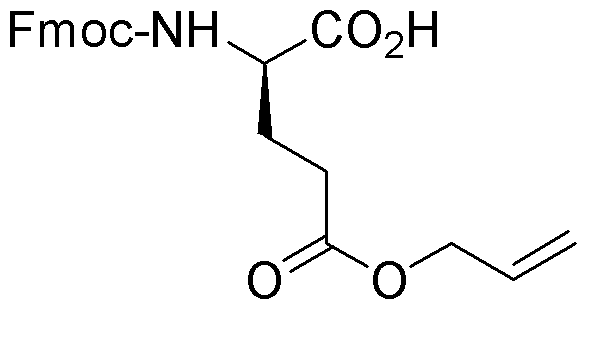Fmoc-D-glutamic acid g-allyl ester is widely utilized in research focused on:
- Peptide Synthesis: This compound serves as a key building block in the synthesis of peptides, allowing for the introduction of functional groups that enhance solubility and stability.
- Drug Development: It plays a significant role in the pharmaceutical industry for developing new drugs, particularly in creating compounds that target specific biological pathways.
- Bioconjugation: Researchers use this chemical for bioconjugation processes, which involve attaching biomolecules to drugs or imaging agents, improving their efficacy and targeting capabilities.
- Research in Neuroscience: Its derivatives are explored in neuroscience research for their potential to modulate neurotransmitter systems, providing insights into neurological disorders.
- Material Science: The compound is also applied in the development of new materials, particularly in creating polymers with specific properties for use in various industrial applications.
General Information
Properties
Safety and Regulations
Applications
Fmoc-D-glutamic acid g-allyl ester is widely utilized in research focused on:
- Peptide Synthesis: This compound serves as a key building block in the synthesis of peptides, allowing for the introduction of functional groups that enhance solubility and stability.
- Drug Development: It plays a significant role in the pharmaceutical industry for developing new drugs, particularly in creating compounds that target specific biological pathways.
- Bioconjugation: Researchers use this chemical for bioconjugation processes, which involve attaching biomolecules to drugs or imaging agents, improving their efficacy and targeting capabilities.
- Research in Neuroscience: Its derivatives are explored in neuroscience research for their potential to modulate neurotransmitter systems, providing insights into neurological disorders.
- Material Science: The compound is also applied in the development of new materials, particularly in creating polymers with specific properties for use in various industrial applications.
Documents
Safety Data Sheets (SDS)
The SDS provides comprehensive safety information on handling, storage, and disposal of the product.
Product Specification (PS)
The PS provides a comprehensive breakdown of the product’s properties, including chemical composition, physical state, purity, and storage requirements. It also details acceptable quality ranges and the product's intended applications.
Certificates of Analysis (COA)
Search for Certificates of Analysis (COA) by entering the products Lot Number. Lot and Batch Numbers can be found on a product’s label following the words ‘Lot’ or ‘Batch’.
Número de catálogo
Número de lote/lote
Certificates Of Origin (COO)
This COO confirms the country where the product was manufactured, and also details the materials and components used in it and whether it is derived from natural, synthetic, or other specific sources. This certificate may be required for customs, trade, and regulatory compliance.
Número de catálogo
Número de lote/lote
Safety Data Sheets (SDS)
The SDS provides comprehensive safety information on handling, storage, and disposal of the product.
DownloadProduct Specification (PS)
The PS provides a comprehensive breakdown of the product’s properties, including chemical composition, physical state, purity, and storage requirements. It also details acceptable quality ranges and the product's intended applications.
DownloadCertificates of Analysis (COA)
Search for Certificates of Analysis (COA) by entering the products Lot Number. Lot and Batch Numbers can be found on a product’s label following the words ‘Lot’ or ‘Batch’.
Número de catálogo
Número de lote/lote
Certificates Of Origin (COO)
This COO confirms the country where the product was manufactured, and also details the materials and components used in it and whether it is derived from natural, synthetic, or other specific sources. This certificate may be required for customs, trade, and regulatory compliance.


